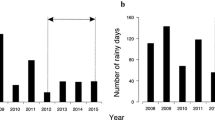Summary
Populations of 4 geospizine finches were studied on Isla Daphne Major in April and December 1973. Finches were captured, banded, measured and released in both months, and censused in December. 1640±711 finches were estimated to be present in December, of which probably more than 1000 belonged to Geospiza fortis. G. fortis were 4 times more numerous than G. scandens. The overal density at this time was 27–54/ha. This is the first quantitative estimate of finch population sizes for a whole island in the Galápagos Archipelago. Some G. fuliginosa and magnirostris immigrated between study periods, but overall density remained nearly constant. There was no evidence of immigration of fortis and scandens. Survival rates of the two common species, fortis and scandens, from April to December were estimated, from banded birds, to be 86.9% and 91.3%. Up to 300 finches (fortis and scandens) disappeared between study periods. The amount of predation by owls (Asio flammeus), estimated from an analysis of 49 pellets, could account for more than 50% of the finch losses, but is likely to be less. The estimated loss due to predation was less than 10% of the populations in April.
The discovery of the remains of house mice, Mus musculus, and black rats, Rattus rattus, in pellets indicates that owls hunt on one island (e.g. Santa Cruz or Baltra) and regurgitate on another (Daphne). Fruits of a Euphorb, Chamaesyce amplexicaulis (Hook. f.) Burch, that finches eat were found in two pellets that also contained finch remains. This suggests that seeds or fruits in the throat of a victim at the time of a kill may be transported unharmed inside an owl from one island to another. Indirect support to this suggestion is given by the results of flotation experiments with seeds and fruits of 22 species of plants. Most did not float, and are too heavy to be transported by normal winds. Many do not have hooks or sticky surfaces, and internal transport by birds (including owls) is therefore strongly suggested.
Similar content being viewed by others
References
Abbott, I., Abbott, L. K., Grant, P. R.: Ecology and evolution of Galápagos ground finches (Geospiza). MS in preparation
Abs, M., Curio, E., Kramer, P., Niethammer, J.: Zur ernährungsweise der Eulen auf Galápagos. Ergebnisse der Deutschen Galápagos-Expedition 1962/63. IX. J. Ornith. 106, 49–57 (1965)
Bailey, N. T.: Improvements in the interpretation of recapture data. J. Anim. Ecol. 21, 120–127 (1952)
Beebe, W.: Galápagos: world's end. New York: Putnams 1924
Bowman, R. I.: Morphological differentiation and adaptation in the Galápagos finches. Univ. Calif. Publ. Zool. 58, 1–302 (1961)
Carlquist, S.: The biota of long-distance dispersal. V. Plant dispersal to Pacific Islands. Bull. Torrey Botan. Club. 94, 129–162 (1967)
Carlquist, S.: Island biology, New York: Columbia Univ. Press 1974
Chitty, D.: A laboratory study of pellet formation in the short-eared owl (Asio flammeus). Proc. zool. Soc. London 108A, 267–287 (1938)
Curio, E.: Zur geographischen Variation des Feinderkennens einiger Darwinfinken (Geospizidae). Zool. Anz. 28, Suppl., 466–492 (1965)
Darroch, J. N.: The two-sample capture-recapture census when tagging and sampling are stratified. Biometrika 48, 241–260 (1961)
DeVlaming, V., Proctor, V. W.: Dispersal of aquatic organisms: viability of seeds recovered from the droppings of captive killdeer and mallard ducks. Amer. J. Bot. 55, 20–26 (1968)
deVries, T.: A study of the Galápagos hawk, Buteo galapagoensis. Unpubl. Ph.D. thesis, University of Amsterdam (1973)
Gifford, E. W.: Field notes on the land birds of the Galápagos Islands and of Cocos Island, Costa Rica. Proc. Calif. Acad. Sci. ser. 4, 2, 189–258 (1919)
Grant, P. R.: Population variation on islands. Proc. 16th Internat. Ornithol. Congr., Canberra, Australia, 1974 (1975)
Grant, P. R., Grant, B. R., Smith, J. N. M., Abbott, I., Abbott, L. K.: Darwin's finches: population variation and natural selection. MS in preparation
Harris, M. P.: Breeding seasons of sea-birds in the Galápagos Islands. J. Zool. (Lond.) 159, 145–165 (1969a)
Harris, M. P.: The biology of the storm petrels in the Galápagos Islands. Proc. Calif. Acad. Sci. 37, 95–166 (1969b)
Harris, M. P.: The Galápagos avifauna. Condor 75, 265–278 (1973)
Holling, C. S.: The components of predation as revealed by a study of small mammal predation in the European pine sawfly. Canad. Entomol. 91, 293–320 (1959)
Lack, D.: Darwin's finches. Cambridge: Univ. Press 1947
Lévêque, R., Bowman, R. I., Billeb, S. L.: Migrants in the Galápagos area. Condor 68 81–101 (1966)
Mayr, E.: Animal species and evolution. Cambridge, Mass.: Belknap Press 1963
Rick, C. M.: Some plant-animal relations on the Galápagos Islands. In: The Galápagos. Proceedings of the Symposia of the Galápagos International Scientific Project, p. 215–224, R. I. Bowman, ed. Berkeley: Univ. Calif. Press 1966
Roff, D. A.: On the accuracy of some mark-recapture estimators. Oecologia (Berl.) 12, 15–34 (1973)
Southern, H. N.: The natural control of a population of Tawny Owls (Strix aluco). J. Zool. (Lond.) 162, 197–285 (1970)
Southwood, T. R. E.: Ecological methods with particular reference to the study of insect populations. London: Methuen 1966
Stephens, S. G.: Salt water tolerance of seeds of Gossypium species as a possible factor in seed dispersal. Amer. Naturalist 92, 83–92 (1958)
Stephens, S. G.: The potentiality for long-range oceanic dispersal of cotton seeds. Amer. Naturalist 100, 199–210 (1966)
Stephens, S. G., Rick, C. M.: Problems on the origin, dispersal and establishment of the Galápagos cottons. In: The Galápagos. Proceedings of the Symposia of the Galápagos International Scientific Project, p. 201–208, R. I. Bowman, ed. Berkeley: Univ. Calif. Press 1966
Swarth, H.: The avifauna of the Galápagos Islands. Occ. Pap. Calif. Acad. Sci. 18, 1–129 (1931)
Wiggins, I. L., Porter, D. M.: Flora of the Galápagos Islands. Stanford: Univ. Press 1971
Author information
Authors and Affiliations
Rights and permissions
About this article
Cite this article
Grant, P.R., Smith, J.N.M., Grant, B.R. et al. Finch numbers, owl predation and plant dispersal on Isla Daphne Major, Galápagos. Oecologia 19, 239–257 (1975). https://doi.org/10.1007/BF00345308
Received:
Issue Date:
DOI: https://doi.org/10.1007/BF00345308




